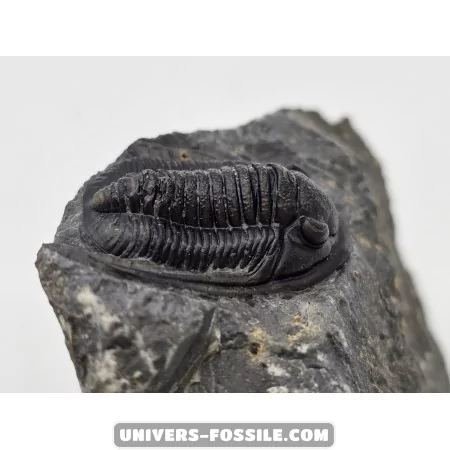Cornuproetus cornutus - Rare Trilobite Fossil for Collectors | Fossil Enthusiasts

Cornuproetus cornutus Trilobites
Cornuproetus cornutus was a medium-sized trilobite belonging to the order Proetida. It lived during the Devonian period, approximately 390 to 360 million years ago. This trilobite was characterized by several distinctive features:
- Body: Like all trilobites, Cornuproetus cornutus had a body divided into three lobes: the cephalon (head), thorax (body), and pygidium (tail).
- Shape: The body of Cornuproetus cornutus was oval and slightly flattened, with an outer surface covered in a hard, segmented exoskeleton.
- Eyes: This trilobite possessed large compound eyes, which likely enabled it to detect movement and light in its environment.
- Spines: A distinctive feature of Cornuproetus cornutus was the presence of two pronounced spines extending from its cephalon, giving it a unique and recognizable appearance.
Habitat and Distribution:
Trilobites, including Cornuproetus cornutus, were primarily marine organisms. They inhabited ancient seas and oceans, displaying a wide distribution across various regions during their existence.
Cornuproetus cornutus – Trilobites
Cornuproetus cornutus was a species of trilobites, ancient marine creatures that lived in the seas during the Devonian period. These fascinating creatures are now extinct, but their fossils provide valuable insights into the past.
Lifestyle
Given that trilobites have been extinct for a long time, our understanding of their lifestyle is based on analyses of their fossils and observations of related species. It is believed that Cornuproetus cornutus was a benthic predator, primarily feeding on small marine organisms that it captured with its specialized mouthparts.
Extinction
Trilobites thrived for hundreds of millions of years but ultimately became extinct at the end of the Paleozoic era, approximately 252 million years ago, during the Permian-Triassic extinction event. The exact causes of their extinction remain a subject of debate among paleontologists, but it is likely related to major environmental changes, such as fluctuations in sea level and massive volcanic eruptions.
Fossil Significance
Trilobites, including Cornuproetus cornutus, are of great importance to paleontologists as they provide valuable information about past biodiversity, the evolution of arthropods, and ancient marine environments.
Cornuproetus cornutus - Rare Trilobite Fossil
Cornuproetus cornutus is a captivating species of trilobite known for its unique features and historical significance. These ancient creatures roamed the Devonian seas, leaving behind remarkable fossils that continue to intrigue researchers and collectors alike.
With its distinctive horn-like projections and intricate exoskeleton, Cornuproetus cornutus stands out as a prized specimen among trilobite enthusiasts. Its fossils offer a glimpse into the ancient marine environments and provide valuable insights into the biodiversity of that era.
These fossils are not only scientifically valuable but also artistically appealing, making them coveted additions to any collection. The intricate details preserved in Cornuproetus cornutus fossils showcase the remarkable craftsmanship of nature and the passage of time.
Whether you are a seasoned collector or a passionate fossil enthusiast, Cornuproetus cornutus deserves a special place in your collection. Explore the world of trilobites and discover the beauty and historical significance of this fascinating species.
